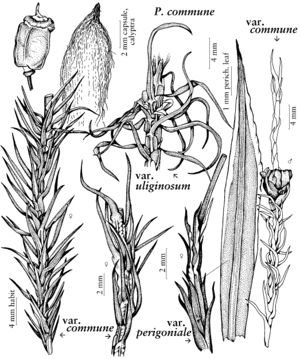Difference between revisions of "Polytrichum commune var. perigoniale"
Linnaea 13: 44. 1839,.
FNA>Volume Importer |
FNA>Volume Importer |
Revision as of 19:38, 24 September 2019
Plants in compact, rather dense tufts. Stems to 6 cm. Leaves densely imbricate and crowded, somewhat less sharply toothed than in var. commune; marginal cells of lamellae in section narrow, more shallowly grooved; perichaetial leaves conspicuous and ribbon-like, exceeding the foliage leaves, mostly hyaline, subentire, ending in a long, nearly smooth awn. Capsule short-rectangular to cubic.
Habitat: Humus and moist sandy soil, open woods, and roadside banks
Elevation: mainly low elevations
Distribution

B.C., N.B., N.S., Ont., Yukon, Alaska, Ark., Conn., Fla., Ill., Ky., La., Maine, Md., Mass., Mich., Mo., N.J., N.Y., N.C., Okla., Pa., R.I., S.C., Tenn., Va., Wash., Wyo., Europe, n Africa.
Discussion
Variety perigoniale has a distinctly “bushy” aspect, the leaves thick set and densely imbricate. The typical expression is common on the Atlantic coastal plain, as in the Pine Barrens of New Jersey (the type was from Carolina). Elsewhere, its distribution and ecology are poorly documented, but it is probably not simply a dry land phase (H. A. Crum and L. E. Anderson 1981), occurring sporadically throughout the range of the species. The perichaetial leaves are not only longer than the foliage leaves, but distinctly ribbon-like, irregularly twisted and curled when dry.
Selected References
None.
